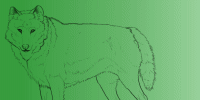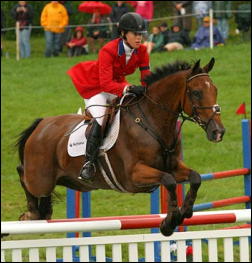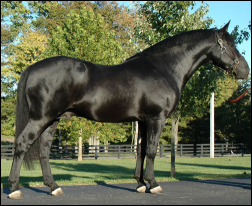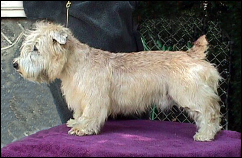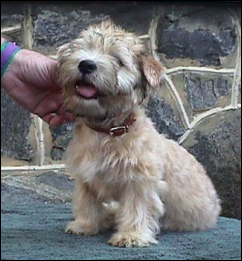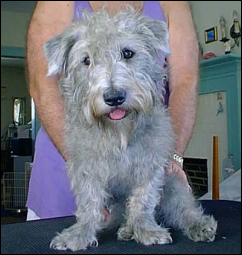|
 BY
JNFERRIGNO
BY
JNFERRIGNO
Those who frequent VHR chat, and even VP may know
the name, Jim. He’s
our very own mischievous Puck in disguise. What some may not know is
that this trickster has a softer side, for the four legged and furry
kind.
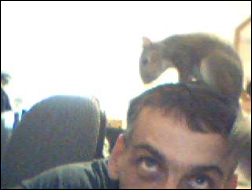
A few years ago, this tree trimmer was out
cutting
limbs, and accidentally cut a squirrel nest down, “I
didn’t
see it at
first, and when I got down out of the bucket and got on the ground I
heard something screaming a lil, so I went looking for it, and I ended
up finding the female squirrel, she still had her eyes closed and no
fur on her, so I gathered some leafs and part of her nest that was on
the ground and put it inside my hard hat .”
A couple years
later, Jim was working at another site when a brave baby boy squirrel
decided he was going to sit on his shoulder, “[guess] he
smelled
the
female squirrel on me and thought I was a safe person, and
couldn’t get
him off, so brought him home and raised him too, he was still pretty
young...only peed on my head maybe two or three times.”
While
some may have chosen to rehabilitate the young squirrels, once they
bond to a human they aren’t really wild any more and it could
be
dangerous to release them. Jim did think about it at first, but
he’s
really a big softy “it was at night when she opened her eyes,
she
crawled out of the box that was beside my bed and got up on my chest ,
scared me at first cause I didn’t know what it was , but
after I
found
out it was her, she climbed back on my chest and went to sleep, and eh,
I couldn’t just release her back out into the wild.”
“When she
was a baby, I called the vets all around and got online to see what
others feed their squirrel, so I went to Wal-Mart and got some
cat’s
milk and fed her with a little baby bottle.” Aside from hand
feeding
the baby squirrels, he also made a Squirrel Room, filled with strong
branches they could climb on. When they got older, Jim started feeding
them all sorts of things, from your typical nuts and fruits, to your
M&M’s and coffee, “[I] have no choice, be
drinking
something and
they would just come up and take them a drink of it.”
It’s
clear here
who really rules the house (sugar raging squirrels looking for a
caffeine fix!).
After talking with Jim quite a while
about his
squirrels, I’ve come to see them as extremely social animals,
probably
even more sociable than my pet rats. “They act like kids. If
you
raise
your voice with them, they know they are in trouble and then sometimes
they'll suck up to you, try to get on your good side again, but they
love to play and sleep. And they are so funny to see when they are
playing. They get on you and love on you, sometimes they will jump
around when they are happy and wanting to play. Both my squirrels
[would groom me].”
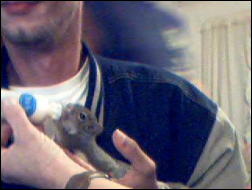
Unfortunately in 2006, both squirrels got sick at
the
same time and Rocky, the female, didn’t pull through,
“I
searched
online, I couldn’t find anything. The vet gave us some meds
and
didn’t
charge us. The male ended up getting better, the female
didn’t.
She got
so bad she [could] hardly walk, or drink anything , had to put
something to drink in like an eye dropper and give it to her like that.
The vets didn’t even know [what they had].” Sadly,
no vet
in the area
had experience with squirrels, but they never did charge Jim anything
when he took them in. Don’t you wish all vets were that
generous?
His
male was never neutered, and he did try to mate with Rocky a few times,
but she’d always turn around and slap him, “guess
she had a
headache.”
Had she lived longer they may have reared a litter together. But
that’s
alright, since Jim has a yard full of squirrels he entertains.
“When
Rocky was little, she got in my shirt pocket one day and we went to
Wal-Mart. Some girls screamed, some girls said ‘awww
cute’,
we used to
put them on a [harness] and take them out for walks, people would look
at me like I was crazy.” One of their favorite past times,
was
taking
car rides with Jim. The two squirrels would lay on his dash board and
catch some sun.
Aside from keeping his sneaky female
from
chewing his cords, one of the most challenging aspects of raising a
squirrel was dealing with their heightened aggression in winter time.
“They become real protective over their food and will bite
you if
you
get too close to where they hide [it].” One day his little
boy
got
tired of Jim trying to steal all his food, and decided he was going to
pack up and head out into the big bad world. He had disappeared for a
whole day, and came back scared to death that evening. Apparently dad
neglected to tell him that the real world wasn’t filled with
M&M’s
and Mello Yellow.
|
 BY ALIAS
BY ALIAS
Virtual Horse Ranch is home to many breeds Native
to Ireland or
descended from Irish horses. Many of these breeds are not so well known
to the players and some are hardly bothered with. For this month I was
asked to write a bit about the different Irish horses in our world.
Irish Sport Horses, known as Irish
Draught Sports Horse in the
United States, or Irish Hunters are the direct cross of an Irish
Draught and the Thoroughbred. Connemara blood can be found in some of
the mares of the breed. This horse is also used for the police force in
Britain and Ireland. Traditionally, the horses were bred for all
purposes including transportation, working the land, and riding of
course. It soon became apparent that these horses would become great
eventers. Its natural athletic abilities and talent in the Jumping
events meant that people began breeding this horse for other events.
They are great for Show Jumping, Eventing, Foxhunting, and in some
cases are used in Endurance races.
They are characterized by an
attractive head with a sometimes
convex or Roman Nose profile. Their necks are slightly arched with a
long sloping shoulder, a deep but not overly broad chest, a short
compact back and a muscular croup with powerful hindquarters. The croup
is often sloping and long, a trait that comes from the Irish Draught,
which improves its jumping abilities. Their heights range from 15-17
hands.
Irish Draughts, which brought along
the Irish Sports, are the
national horse breed of Ireland which was developed mainly for farm
use. Today they are a popular cross with Warm bloods or Thoroughbreds
producing the ISH’s. The breed originated from the Irish
Hobby, a small
ambling horse with many similarities to the Sorraia horses of Northern
Spain and Portugal. War horses brought to Ireland during the
Anglo-Norman invasions were bred with the local stock and produced a
good working horse. Stallions with Clydesdales and Thoroughbred blood
were used on the local Draught mares in the 1800’s with a
sprinkling of
Connemara blood added to the ID’s of today. The breed was to
be docile
and strong, they were required to not only perform the farm work of
pulling carts and ploughing, but they were also used as riding and hunt
horses and during the Great European Wars, they were used as Army
Artillery horses. They were bred to be economical to keep, surviving on
grass and any boiled turnips, oats and bran left over from the cattle
feed.
These horses have a wide forehead,
with a slight Roman nose.
Their shoulders should be clean cut, well defined withers and a neck
set high and carried proudly. The chest should not be too broad or
overly muscular. The legs are strong and firm, with generous hooves.
The back is powerful and the girth is deep. The croup and buttocks are
long and sloping, not short and rounded. 15.3-16.3 hands.
Irish Tinkers and Gypsy Vanners are
actually the same breed! Who
would have guessed? Vanner and Tinker are breed types in Ireland and
not actually separate breeds. The Gypsy Vanner, Gypsy Horse (USA),
Gypsy Cob (USA, UK), Coloured Cob (UK) or ‘Tinker
Horse’ is a breed of
horse which is usually of Tobiano coloring and has many draft horse
characteristics. It’s commonly believed that these horses are
derived
from a combination of Shires, Clydesdales, Friesians, and Dales Ponies
with their origins in the United Kingdom and Ireland. They were bred to
be a wagon horse. They were also children’s riding horses
because of
their small size and docile temperaments. They have only been
recognized as a breed since the 20th century because their bloodlines
were kept secret and only family knew their breeding. |
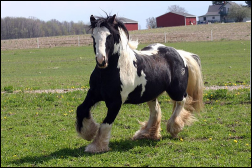 Gypsy Vanner
stallion, at
WillowWind Stables
Gypsy Vanner
stallion, at
WillowWind Stables
These horses are characterized by abundant feathers starting
at
the cannon and flowing down over the hooves. The build is powerful and
compact with a short neck and back. The Gypsy Cob is fairly large,
standing between 14-17 hands. The chest is broad with well sprung ribs,
the hips are heavy. They have short back, strong shoulders and the
withers are rounded. The hair should be straight and silky, kinky hair
is a fault in the breed. Legs should have heavy bone set and their hind
legs should not be too straight. They must have excellent endurance,
and be able to go long distances without tiring.
Another breed that has roots in
Ireland is the all too common
Thoroughbred. The breed is best known for its use in horse racing. They
are considered to be a ‘hot-blooded’ horse, known
for their agility,
speed and spirit. TB’s are mainly used for racing but are
also bred for
other riding disciplines like Show Jumping, Combined Training,
Dressage, Polo, and Fox Hunting. All TB’s can trace their
bloodlines
back to 3 foundation stallions and 74 foundation mares. Today they are
a very versatile horse, used in many different areas, and are one of
the most popular horses owned in the UK and United States.
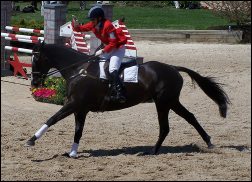
Good quality Thoroughbreds have a well
chiseled head on a long
neck, high withers, a deep chest, a short back, good depth of
hindquarters, a lean body and long legs. Hot-blooded horses are
spirited and bold. TB’s in the Northern Hemisphere become a
year older
on January 1 each year, regardless of their real birth dates. Imagine
having a foal born in the late winter! If your horse was born December
31 and was only 1 day old, it would be one year a day later if it was
to be a race horse!
The Connemara is a pony breed
originating in Ireland that is known for
its athleticism, versatility and good disposition. The breed is made up
by hardy, strong individuals. Some people believe that the Connemara
developed from Scandinavian ponies that the Vikings first brought to
Ireland. They are also thought to have come from the Irish Hobby, the
now extinct breed established prior to the 13th century. The Spanish
Andalusians bred into the stock when the galleons ran a-ground in
Ireland they were set loose. For more strength and stamina, Arabian
blood was added in the 1700’s. The Connemara is most known
today for
their abilities as a sporting pony. They are competitive in Dressage,
Show Jumping and Eventing with the stamina for Endurance riding. They
are also shown in Harness or Carting.
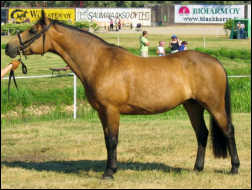
Connemara’s are strong and
sturdy with a short back and sloped,
muscular croup. The hindquarters are powerful, supported by short,
strong legs and hard feet with a good stride length. The breed has a
fine head with small ears and an a slightly dished profile coming from
the Arabian blood, set on a well arched neck. They are lively and eager
with a trainable temperament. They are considered to have a good
jumping ability. They can be anywhere from 12.2-15 hands by breed
standards.
Whatever breed of Irish horse you are
looking at, it seems to be
standard that these horses are going to be easy keepers, great
companions and hard workers. There is not faulting the breeding of
horses that are versatile and strong from the Irish lands. Hopefully
now, people can see these horses in a new light and become more
interested in improving the breeds beyond what they are now and turning
them into a more popular type of horse to own.
|
 BY
JNFERRIGNO
BY
JNFERRIGNO
1
cup
oatmeal
1 cup flour
1/2 cup vegetable oil
1 cup water
1/2 sugar (packed)
2 eggs
1 apple peeled and shredded
2 large carrots shredded
2/3 cup honey
1 cup green crushed mints
|
Pre-heat your oven to 400 degrees. And check the cookies around 7 to 10
minutes. I forgot the exact time on these but they should be nice and
crispy. Some things you can sub. is 3 table spoons of apple sauce for
one egg, molassas for honey (the cookie will be darker), wheat flour
for regular flower, wheat germ oil for veggie oil. You can also add
green food coloring. After everything is mixed, using a well floured
board roll out the dough and cut into shamrock shapes. You will need to
keep extra flour on hand to prevent dough from sticking. Top with green
crushed up mints, and bake. You can use this recipie for dogs, but
leave out the crushed mint. You can also give this raw, just leave out
the flour.
|
|
|
 WRITTEN BY
JNFERRIGNO, PHOTOS BY HOLLY BEST
WRITTEN BY
JNFERRIGNO, PHOTOS BY HOLLY BEST
The Kerry Blue and Irish Terrier were bred for catching
vermin, while
the Soft Coated Wheaten Terrier for all around farm work. This covers
all the Terrier breeds for Ireland right? – Wrong. There is one
more
breed, unknown to the VirtualPups community, and that dog is called a
Glen of Imaal Terrier.
Similar to a Wheaten Terrier, but with
short legs, this little dog’s original job was not vermin
hunting, but
turnspiting – a glorified canine driven rotisserie if you will.
This
low compact dog with bowed front legs and a powerful hind end, was
perfect for propelling the large wheel which hung next to the hearth
and turned skewered meat over the fire. Eventually this breed was bred
for a more specific purpose of hunting larger game like Fox and
Badgers, and not necessarily vermin, although it is a very capable
verminator. Of the Irish Terriers, the Glen has the purest heritage, in
the sense that their prey-drive and unique personality has not been
bred out of them. While this 14 inch dog is often seen as small by
those who have never owned one, this never got that memo. Everything
about them is grandiose, their personality, their determination, their
intelligence, and yes, even their aggression.
I am in by no
means saying this is a dangerous unpredictable dog to own. Far from it.
But is it a dog for everyone? That answer is, No. This is a working
breed, one that is extremely prey-driven, and should not be left
unsupervised or non-socialized. This does not mean throwing them in a
crate or kennel will solve your problem. Glens actually desire to be a
family member, |
and confined type
of environment often leads to
bouts of
aggression. Many people often mistake smaller dogs for companion dogs,
or dogs which are great with children. This false sense of security
often ends up with an unwanted, untrained dog, because many do not
know
how to properly socialize. This isn’t to say they are not an
ideal
family dog, however the potential buyer and even owner must make every
effort to properly socialize their Glen, as well as insuring that
it’s
supervised around small children. Like many terrier breeds, the Glen is
dog aggressive, with a strong drive to chase and in most cases kill,
small animals resembling prey. More often then not, owners don’t
see it
coming since the Glen does very little posturing, and are rather
straight to the point. Owners and potential buyers of an Glen have to
consider the liability of this aggression, and maintain a diligent
training program. However, even with training, these traits can not be
trained ‘out’ of the Glen. This is who they are. Love it or
leave it,
but for what it’s worth they have the capability of being your
most
trusted companion.
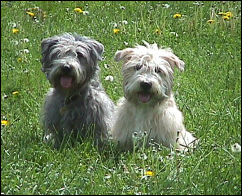
Holly Best, coordinator of the North
American Glen Rescue and co-owner of Powheiri Kennels, has been
selectively breeding and raising Glens for 13 years. She recognizes the
breeds unique quirks, and makes sure potential buyers are well aware of
the time that needs to go into these dogs, “although they are
strong
willed and can be stubborn and domineering, they are also very
interested in belonging and indeed, thrive on it.” Glens are not
considered yappy dogs, although they have the bark of a Great Dane. But
this appears to be linked more to their training, and not necessarily a
breed trait. Depending on the Glens job you assign it, will depend on
the amount of barking it will do. Glens show a high level of
intelligence, and because of this they can become bored easily. While
they catch on quickly, they still have a stubborn streak, which is why
it is important to note that consistency and time are key here, and
physical discipline often leads to bigger problems. In some ways, they
are like a companion dog but with a greater purpose. Even though they
have a strong drive, they appear the most comfortable laying on their
masters feet. With proper training Glens often become extremely loyal
and protective companions over the house hold. “What I cherish
most
about Glens is their sense of humor! What I respect most is their
strength and ability to do their job as a working terrier,” says
Holly.
This comical personality appears to be the common theme among breeders,
and it’s often said that a Glen is like no other dog.
|
As a breed Glens are rather healthy. However like all
breeds, there are
exceptions to these standards. On occasion Glens may develop skin
conditions, however Holly believes this is more commonly link to diet
and nutrition since it’s a condition seen in all dogs. To prevent
this,
as well as insure the rearing of healthier and happier dogs at
Powheiri, Holly has practiced a natural program with great success. A
true raw diet, along with holistic medicine teamed with veterinary care
when needed, has insured that this kennel breeds stronger, healthier
and happier Glens. The only genetic disease that seems to afflict the
Glens as a breed is Progressive Retinal Atrophy (PRA). PRA is not
painful, but does result in the slow loss of vision, and dogs that are
double carriers start to show signs anywhere from 3 to 7 years of age.
In 2004 there wasn’t a test which determined who was a carrier
and who
wasn’t. At the time the only way to tell was once PRA started to
take
effect. Thankfully now there is a DNA test that can be administered,
and this has put many breeders at ease. Vets agree that out of all the
different causes of blindness seen in canines, they would rather see a
dog with PRA since it is not painful to the animal, and it can
gradually get accustomed to their lack of vision.
Unlike the other Irish
Terriers, Glens are not defined by coat color. They can come in
wheaten, blue, and brindle, and will often not reach full color
maturity till around 5 years of age. A Glens coat is made of hair
instead of fur, so weekly brushing is needed to remove the dead
strands. They have a harsh coat and a softer under coat like that seen
in other terriers, and should be striped many times throughout the
year. With regular striping, your Glen will benefit from a lack of dirt
and debris that can get tangled, as well as a easy coat to brush. The
standard for this breed is to appear natural, and unlike many other
terrier breeds, Glen’s do not need to take trips to the groomer.
It is
these natural characteristics of a Glens heritage, which Powheiri
Kennels, and fellow Glennies, strive to preserve.
|
|
|
 |
 |
|









